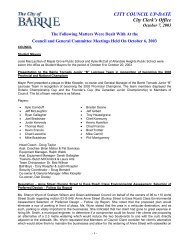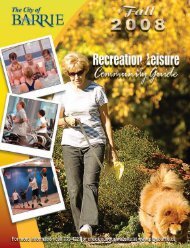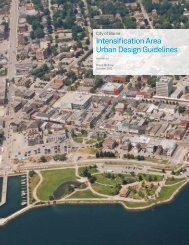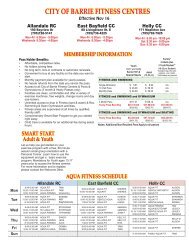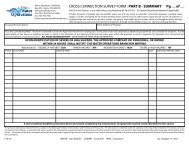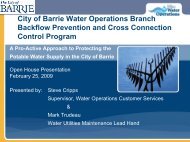Landfill Re-engineering Air Quality, Odour and Health ... - City of Barrie
Landfill Re-engineering Air Quality, Odour and Health ... - City of Barrie
Landfill Re-engineering Air Quality, Odour and Health ... - City of Barrie
You also want an ePaper? Increase the reach of your titles
YUMPU automatically turns print PDFs into web optimized ePapers that Google loves.
Findings<br />
<strong>L<strong>and</strong>fill</strong> <strong>Re</strong>-<strong>engineering</strong><br />
<strong>Air</strong> <strong>Quality</strong>, <strong>Odour</strong> <strong>and</strong> <strong>Health</strong> Assessment Summary<br />
Gases generated from the waste at the <strong>Barrie</strong> <strong>L<strong>and</strong>fill</strong> do not pose a human health concern to the<br />
nearby community. Ambient air concentrations next to the operations area <strong>and</strong> the property<br />
boundary <strong>of</strong> the l<strong>and</strong>fill are below the Ontario Ministry <strong>of</strong> the Environment’s criteria <strong>and</strong> screening<br />
levels. These criteria have been developed to protect human health <strong>and</strong> the environment. The<br />
ambient air concentrations for most <strong>of</strong> the l<strong>and</strong>fill gases were also below their corresponding odour<br />
threshold limits. Therefore, these compounds are not expected to cause odours. If odours are<br />
detected by the community, they are primarily from sulphur-containing compounds <strong>and</strong> odour control<br />
mechanisms are in place to minimize these as much as possible.<br />
Background<br />
The <strong>City</strong> <strong>of</strong> <strong>Barrie</strong> retained Golder Associates Ltd. (Golder) to complete an air quality, odour <strong>and</strong><br />
health assessment at the <strong>Barrie</strong> <strong>L<strong>and</strong>fill</strong> to address concerns <strong>of</strong> neighbouring residents related to<br />
odour originating from the l<strong>and</strong>fill. The study evaluated air quality data from samples collected by<br />
Golder in August <strong>and</strong> September 2010. The air samples were tested for a comprehensive list <strong>of</strong><br />
compounds, which were considered to be potentially present in gases generated within the waste.<br />
Samples were collected from point sources within the waste, as well as from ambient air within the<br />
area <strong>of</strong> the reclamation <strong>and</strong> waste compaction operations, <strong>and</strong> at the property boundary. These<br />
samples are considered to be representative <strong>of</strong> the sources <strong>and</strong> air quality during regular operations.<br />
The health study evaluated the compounds reported in the ambient air samples to determine if they<br />
posed a health concern for the nearby community.<br />
<strong>Odour</strong> Assessment<br />
The concentrations <strong>of</strong> compounds in the ambient air adjacent to the operations area <strong>and</strong> the property<br />
boundary <strong>of</strong> the <strong>Barrie</strong> <strong>L<strong>and</strong>fill</strong> were compared to odour threshold limits at which the average person<br />
will detect odour. The ambient air concentrations for most <strong>of</strong> the l<strong>and</strong>fill gases were below their<br />
corresponding odour threshold limits <strong>and</strong>, as a result, these compounds would not be expected to<br />
cause odours. Whereas concentrations <strong>of</strong> ammonia in ambient air are below its corresponding odour<br />
threshold limit, the concentrations measured in the point sources within the l<strong>and</strong>fill were elevated. It<br />
is considered possible that, at certain times, ammonia may be contributing to odour sensed downwind<br />
<strong>of</strong> the l<strong>and</strong>fill.<br />
Sulphur-containing compounds were not detected in the ambient air samples, although it is expected<br />
that these are the compounds causing some <strong>of</strong> the odours from the l<strong>and</strong>fill. This is because the level<br />
at which laboratories are capable <strong>of</strong> analyzing these sulphur-containing compounds in air samples<br />
are 1,000 to 10,000 times higher than their corresponding odour threshold limits (that is, the average<br />
person can detect sulphur-containing compounds at concentrations well below what the laboratory<br />
can analyze). Sulphur-containing compounds can cause nuisance odours such as rotten cabbage<br />
smell (ethyl or methyl mercaptan) or rotten egg smell (hydrogen sulphide). These compounds are<br />
considered to be one <strong>of</strong> the primary sources <strong>of</strong> odour from the l<strong>and</strong>fill.
<strong>L<strong>and</strong>fill</strong> <strong>Re</strong>-<strong>engineering</strong><br />
<strong>Air</strong> <strong>Quality</strong>, <strong>Odour</strong> <strong>and</strong> <strong>Health</strong> Assessment Summary<br />
The odour control products used at the l<strong>and</strong>fill are considered to be safe for use on the basis that they<br />
have been applied according to manufacturer’s recommendations <strong>and</strong> the key ingredients are<br />
approved for use in cosmetics <strong>and</strong> food products.<br />
<strong>Air</strong> <strong>Quality</strong> <strong>Health</strong> Assessment<br />
Ambient air concentrations were compared to environmental guidelines <strong>and</strong> health-based<br />
benchmarks to provide an indication <strong>of</strong> which <strong>of</strong> the detected compounds are most likely to pose a<br />
health concern to the local community.<br />
Ambient air concentrations are below the air criteria <strong>and</strong> screening levels developed by the Ontario<br />
Ministry <strong>of</strong> the Environment to protect human health <strong>and</strong> the environment. The health assessment<br />
was completed assuming that nearby residents are exposed on a daily basis for a prolonged period <strong>of</strong><br />
time. The health assessment followed methods approved by the Ontario Ministry <strong>of</strong> the Environment<br />
<strong>and</strong> <strong>Health</strong> Canada. The findings <strong>of</strong> our assessment indicated that the gases generated within the<br />
waste do not pose a human health concern to the nearby community.<br />
Who Do I Contact With Questions?<br />
The <strong>City</strong> <strong>of</strong> <strong>Barrie</strong> is planning to host an open house in 2011 to provide an opportunity for further<br />
discussion <strong>of</strong> these results. Until then, the <strong>City</strong> welcomes any questions or comments you may have.<br />
If you would like to arrange a tour <strong>of</strong> the l<strong>and</strong>fill site, or a one-on-one meeting, please contact S<strong>and</strong>y<br />
Coulter at (705) 739-4220 ext. 5826, or by email at scoulter@barrie.ca. More information about the<br />
project is also available on our website www.barrie.ca.



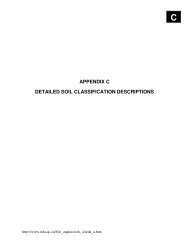
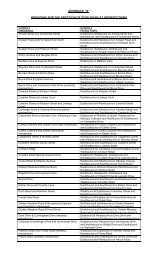


![Water Specification [DOC] - City of Barrie](https://img.yumpu.com/11698186/1/190x245/water-specification-doc-city-of-barrie.jpg?quality=85)

